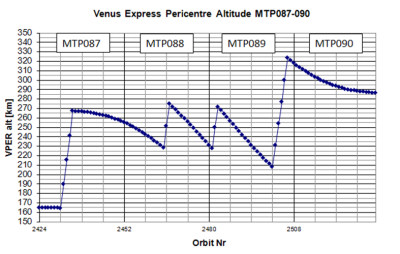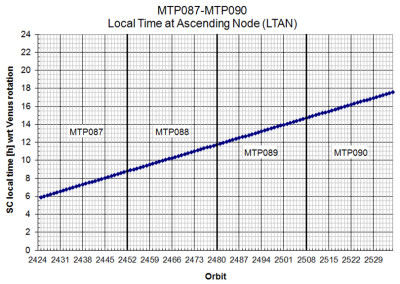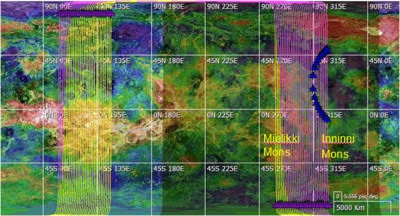No. 255 - Start of the fourteenth Earth occultation season, completion of the tenth Atmospheric Drag Experiment campaign
Cebreros ground station
All Cebreros ground station activities were nominal during this reporting period. The spacecraft systems, payload and ground stations showed excellent performance.
Regular maintenance of the ground station was scheduled on 17 and 18 December 2012. Such maintenance activities and regular data downlinks from the spacecraft are carried out during the day in order to minimise operational costs. This means that the ground station is unavailable for part of the work day (from 11:00 hrs to 16:00 hrs local time) while maintenance activities are carried out. Thus, the time available for data downlinks from the spacecraft is reduced on days when ground station maintenance is performed.
Start of the fourteenth Earth occultation season
The fourteenth Earth occultation season started on 30 December 2012. Occultation measurements were performed during the last seven orbits of this planning period.
For further information, please see 'Venus Express Earth occultation seasons' – linked from the right-hand menu.
Tenth Atmospheric Drag Experiment campaign
The tenth Atmospheric Drag Experiment (ADE) campaign started in the previous reporting period and ended on 15 December.
The ADE passes started at a pericentre altitude of 166 km on 4 December 2012. Seven drag passes were performed in the first seven orbits of this planning period. Of the seven drag passes in this period, three were performed in conjunction with the NASA Deep Space Network (DSN) 70-m antenna in Canberra, Australia on 10, 12 and 14 December 2012; and four were carried out in conjunction with the ESA's 35-m Deep Space Antenna at New Norcia, Australia (DSA-1) on 9, 11, 13 and 15 December 2012.
During these campaigns, the spacecraft body and on-board gyroscopes are used as the instrument to provide data on the extreme upper atmosphere. By measuring its integrated effect on the spacecraft's attitude and position in orbit, the atmospheric density can be determined. During this campaign, the spacecraft's pericentre was allowed to decrease beyond its nominal altitude, down to 165 km as the spacecraft flew over the northern pole of Venus. During closest approach, the spacecraft's solar panels are tilted to induce a very tiny roll in the spacecraft. This roll is countered by the reaction wheels, and the change in reaction wheel speeds can be used to determine the density of the atmosphere at this extreme upper altitude. The amount of drag experienced by the spacecraft is significantly lower than that which would be experienced during an aerobraking orbit change. The drag is maintained at this level, which is known to cause no problems for the spacecraft.
For more information on ADE campaigns, see the link in the right-hand menu.
High accuracy spacecraft ranging
The New Norcia and Cebreros ground stations were used for a Delta Differential One-way Ranging (delta-DOR, or DDOR) measurement on 24 December. These measurements are carried out with the Venus Express spacecraft on a regular basis to support the accurate determination of the ephemeris for the planet Venus that is maintained by NASA's Solar System Dynamics Group.
For more information about DDOR, see the "Delta-DOR measurements" link in the right-hand menu.
Orbit correction manoeuvres
Five orbit correction manoeuvres were planned during this reporting period. The first was performed at pericentre on 16 December. The remaining four were performed from 16 to 19 September at the apocentre. It is interesting to occasionally look at the accuracy achieved in the correction manoeuvres.
The orbit correction manoeuvre executed on 16 December had a nominal magnitude of 0.7127 m/s. It was a retrograde manoeuvre at pericentre, meaning that the burn was performed against the direction of travel, with the intention of lowering the apocentre altitude by 133 km and decreasing the orbital period by 220 s. The post-burn analysis showed an underperformance of 0.33% (2.4 mm/s less than planned). The apocentre altitude was decreased by 440 m less than originally planned and the orbital period was decreased by 0.7 s less than planned.
Four prograde burns (in the direction of travel) were executed at successive apocentres on 16-19 December in order to raise the pericentre altitude. The first three burns each had nominal magnitudes of 1.600 m/s and the fourth a nominal magnitude of 1.470 m/s. Their total effect was designed to raise the pericentre altitude by 101 km and increase the orbital period by 166 s. Overall, the new pericentre altitude was off the target value by only 360 m less than planned. The orbital period, which is kept close to a 24-hour period, was off the target value by only 0.6 s less than planned.
 |
|
Change in Venus Express pericentre altitude during the period from 9 December 2012 to 30 March 2013. Credit: ESA |
After all five manoeuvres, the net decrease in the orbital period was only 0.1 s less than planned.
Spacecraft clock synchronised
The clock on the Venus Express spacecraft is a simple count-up timer, typical of those used on spacecraft. These clocks save weight and cost but they tend to drift, and must be synchronised – or correlated – with atomic clocks on Earth at regular intervals. One of these regular time correlations was performed on 18 December 2012.
Summary of main activities
The table below shows a chronology of the main spacecraft bus activities in the reporting period.
| Main activities during reporting period | |||
|
ADE = Atmospheric Drag Experiment; CEB = Cebreros; DOR = Differential One-way Ranging; DOY = Day of year; MET = Mission elapsed time; NNO = New Norcia; OCM = Orbit Correction Manoeuvre; WOL = Wheel Off Loading |
|||
|
MET (Day) |
Date | DOY | Main Activity |
| 2588 | 09-Dec-2012 | 344 | ADE around pericentre; CEB communication pass interrupted by WOL |
| 2589 | 10-Dec-2012 | 345 | ADE around pericentre; CEB communication pass interrupted by WOL |
| 2590 | 11-Dec-2012 | 346 | ADE around pericentre; CEB communication pass interrupted by WOL |
| 2591 | 12-Dec-2012 | 347 | ADE around pericentre; CEB communication pass interrupted by WOL |
| 2592 | 13-Dec-2012 | 348 | ADE around pericentre; CEB communication pass interrupted by WOL |
| 2593 | 14-Dec-2012 | 349 | ADE around pericentre; CEB communication pass interrupted by WOL |
| 2594 | 15-Dec-2012 | 350 | ADE around pericentre; CEB communication pass interrupted by WOL |
| 2595 | 16-Dec-2012 | 351 | CEB communications pass. OCMs at apocentre and pericentre |
| 2596 | 17-Dec-2012 | 352 | CEB communications pass. CEB maintenance 11:00 hrs to 16:00 hrs. OCM at apocentre |
| 2597 | 18-Dec-2012 | 353 | CEB communications pass. CEB maintenance 11:00 hrs to 16:00 hrs. OCM at apocentre |
| 2598 | 19-Dec-2012 | 354 | CEB communications pass. OCM at apocentre |
| 2599 | 20-Dec-2012 | 355 | CEB communications pass |
| 2600 | 21-Dec-2012 | 356 | CEB communications pass |
| 2601 | 22-Dec-2012 | 357 | CEB communications pass |
| 2602 | 23-Dec-2012 | 358 | CEB communications pass |
| 2603 | 24-Dec-2012 | 359 | CEB communications pass. NNO Delta DOR pass |
| 2604 | 25-Dec-2012 | 360 | CEB communication pass |
| 2605 | 26-Dec-2012 | 361 | CEB communication pass |
| 2606 | 27-Dec-2012 | 362 | CEB communication pass |
| 2607 | 28-Dec-2012 | 363 | CEB communication pass |
| 2608 | 29-Dec-2012 | 364 | CEB communication pass |
| 2609 | 30-Dec-2012 | 365 | Occultation with NNO at pericentre. CEB communication pass |
| 2610 | 31-Dec-2012 | 366 | Occultation with NNO at pericentre. CEB communication pass |
| 2611 | 01-Jan-2013 | 001 | Occultation with NNO at pericentre. CEB communication pass |
| 2612 | 02-Jan-2013 | 002 | Occultation with NNO at pericentre. CEB communication pass |
| 2613 | 03-Jan-2013 | 003 | Occultation with NNO at pericentre. CEB communication pass |
| 2614 | 04-Jan-2013 | 004 | Occultation with NNO at pericentre. CEB communication pass |
| 2615 | 05-Jan-2013 | 005 | Occultation with NNO at pericentre. CEB communication pass |
At the end of the reporting period on 5 January 2013 Venus Express was 234.6 million km from Earth. The one-way signal travel time was 782 s. The final oxidizer mass was 22.284 kg and the final fuel mass was 13.708 kg.
Scientific focus
This reporting period falls under the Medium Term Plan (MTP) 87 and covers the period from 9 December 2012 to 5 January 2013. The data rate was moderately low during this period. The fourteenth Earth occultation season started on 30 December 2012. The tenth Atmospheric Drag Experiment (ADE) campaign continued during this reporting period and ended on 15 December.
Local time at ascending node changed from 05:40 hrs to 08:40 hrs. This meant that the season was 'cold', so that pointing the +Z instrument face of the spacecraft at nadir did not expose any thermally sensitive faces of the spacecraft to the Sun.
 |
|
Venus Express LTAN from 9 December 2012 to 30 March 2013. Credit: ESA |
The observation geometry allowed the Visible and Infrared Thermal Imaging Spectrometer (VIRTIS) to again target two volcanoes that may possibly have been active recently (in geological time scales): Mielikki Mons (-80°E, -28°N) and Inninni Mons (-31.7°E, -34.7°N).
 |
|
Venus Express coverage of Venus (9 December 2012 until 5 January 2013). Credit: ESA |
Payload activities
During this 28-day period, one minor anomaly occurred with the Venus Express SPICAV instrument. The other science instruments performed nominally.
| ASPERA | The instrument was regularly operated nominally as part of the routine plan. |
| MAG | The instrument was regularly operated nominally as part of the routine plan. |
| PFS | The instrument was not operated. |
| SPICAV |
The instrument was regularly operated nominally as part of the routine plan. On 4 January 2013, one of the scheduled observations produced telemetry packets with bad time stamps. This has been seen before on rare occasions, and the cause had not been determined. All subsequent observations were nominal. |
| VMC | The instrument was regularly operated nominally as part of the routine plan. |
| VeRa | The instrument was regularly operated nominally for the Earth occultation observations. |
| VIRTIS | The instrument was regularly operated nominally as part of the routine plan. |
Future milestones
- Start of the twenty-third solar eclipse season
- Start of the surface imaging campaign
- Continuation and end of the fourteenth radio science occultation season
---
Legal disclaimer
This report is based on four ESOC mission operations reports, MOR #368 through MOR #371, as well as the MTP087 Master Science Plan. Please see the copyright section of the legal disclaimer (bottom of this page) for terms of use.



